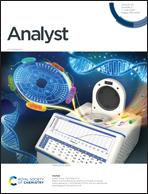IL@CQD catalyzed active ester rearrangement for the detection and removal of cyanide ions†
Abstract
Carbon Quantum Dots (CQDs) have been extensively employed in various fields of science such as sensing, catalysis, and drug delivery. In this work, ionic liquid coated CQDs (IL@CQDs) have been used as catalysts for the rearrangement of a 1-ethyl-3-(3-dimethylaminopropyl)carbodiimide (EDC) amide coupling intermediate. The rearranged product was confirmed by single crystal structure analysis and it was processed into organic nanoparticles (ONPs). An optical detection method was used to scrutinize the anion sensing properties. The ONPs were found to be sensitive and selective for the recognition of highly toxic cyanide ions through enhancement in the fluorescence intensity. The cyanide ion co-ordinates with the –NH groups of the product and restricts the rotation of molecules around the single bond. The ONPs coated over silica-beads were also showing CN− recognition in the solid state. The detection limit for CN− sensing was found to be 3.8 nM, and real sample analysis depicts more than 90% accuracy in detection.



 Please wait while we load your content...
Please wait while we load your content...